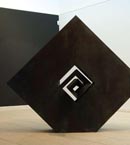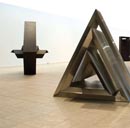Who is the author of this incredible exhibit?
The author is an almost hermetical person, but with a deep internal eloquence. He was basically trained in Europe, mainly in the socialist Czechoslovakia, and was born at the hospitable and swaying city of Santiago de Cuba. José Villa Soberón has unique qualities for sculpture, and one of them which I consider to be the most important, is that of observing everything around him with a sharp and analytical pupil. The other thing is that he owns a creative sensibility of an absolute authenticity. Confident, unmistakable, his universe moves from subjective figuration to concrete abstraction. All in accordance to a doing that encourages transfiguration adventures full of distinctive and personal elements, reminiscent of classic signs such as the spiral and the frets. It is neither difficult to interpret the sumptuous world of metaphors of the artist nor his intellectual discourse. Villa always gives an answer to the mystery of life. He explores that porous cavity of the human species where the fairies of the spirit reside in an impossible arcane. It is an inquiry to the essence of man and his ancestral tribulations. Classical codes that the artist takes as his owns to give us a repertoire of symbols that speak for themselves, it is liberation of subterranean energy materialized in olive-colored steel and in the virile forms of movement. There are just a few Cuban sculptors who are capable of expressing that dimension of being without mannerism or artificiality. Only an artist like him can give such lightness to the most solid and consistent materials he uses. Villa’s pieces do not fit into a museum; Villa’s pieces are opened to the world as a crater, they talk with Theseus and Goliath, they go far beyond the meridian of Greenwich, they are Wagnerian, they seduce and perturb the viewer’s mind, they do not belong to this earthly and prosaic world.
I’m talking, just to make it clear, about Mutantia, his latest exhibition.
No, they do not fit in the museum, no matter how much he might wish it, they get out of their own armor, they do not fit in academic classifications or in those of beauticians. How to explain the extraordinary, the air, the virile and tender elegance once the artist succeeds with the most severe materials, the purest resources... How to define the appropriation of nature through human history in mutant spirals and frets suggestive and classicists? What uneasiness, what restlessness transmits these forms devoid of mannerisms but sensual in its undeniable erotic power and civil discourse?
Laconic, maybe, reminiscent of anthropological currents, without artifice, as its author, Mutantia shows a lyrical visitation to the roots.
Multiple rings of multiple lives; descent into the caves, ascension to the zenith. Now I will contradict the wise critics.
The work presented by Jose Villa Soberón in the halls of the Fine Arts Museum has little or nothing of abstract. The abstraction seen as an assumption of the concrete is not more than an alibi.
The pieces of this sculptor are forms of spirit, primogenial outcries, gasps of the planet, direct signs of historic warp worn out with eroticism and majesty. Inviolable marriage of metal and promethean fire, signs of the time when the landscape claims for toughness. The presumptively abstract work of Villa reveals the artist’s inner explosion, the painful edge of his chisel, his quiet courage. The old questions, the ancestral fears, the certainty of an ethical conduct and the mounting of a contemporary cultural construction make of Mutantia a lesson that while compact in its structure is far from being academical. Come you all to see how a pyramid is done. Come you all to talk to the matter, with Mother Teresa of Calcutta, mute in her concentration, and with the Knight of Paris and its futile small papers, with Antonio Gades and John Lennon, they are true abstractions of the artist on a theme, variations of a human spiral, appropriations of the smoke; the rest, what is inside the Fine Arts Museum, is a hit in the middle of the chest with a mass of concrete. A call to perfection and taste, to sobriety and to the most hieratic composure.
December 2009




Previous publication Clouds in an unchanging sky
Next publication Issues 4 and 5 of Art by Excelencias Magazine Presented in Havana
Related Publications

How Harumi Yamaguchi invented the modern woman in Japan
March 16, 2022
Giovanni Duarte and an orchestra capable of everything
August 26, 2020











